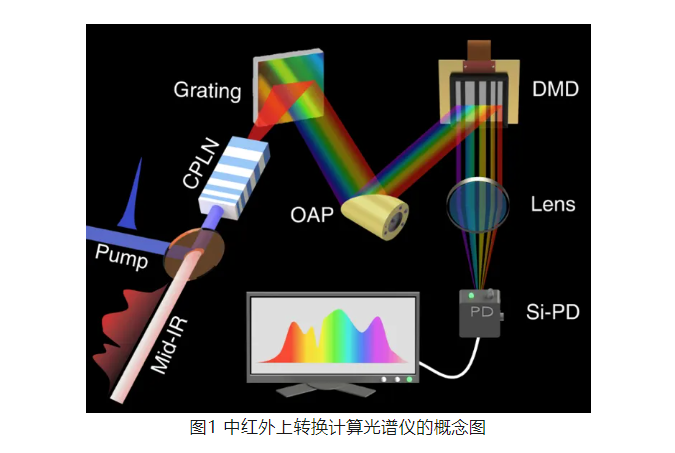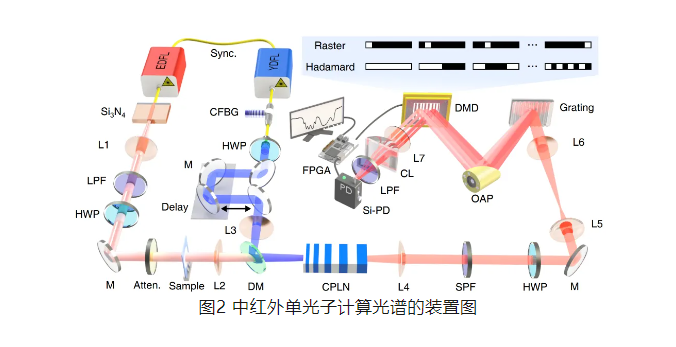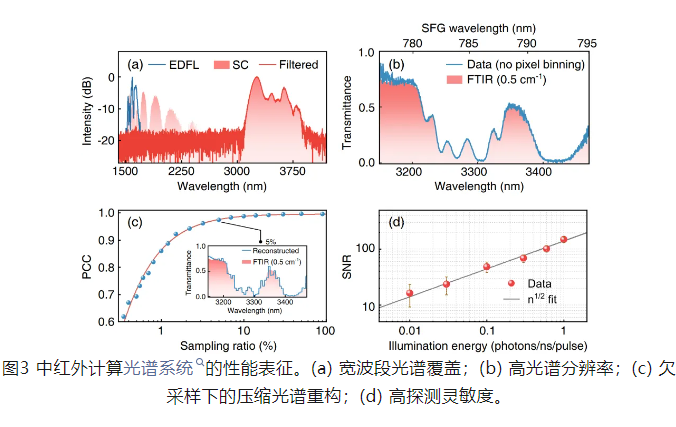15
2024
-
11
Mid-infrared single-photon computational spectrometer
Author:
As a powerful tool for material characterization and identification, mid-infrared spectroscopy is widely used in many fields, such as environment, materials, chemistry and medicine. Especially in many low-light application scenarios, such as long-distance pollution monitoring, non-damage cultural relics identification and low-light toxic cell observation, the demand for high-sensitivity mid-infrared spectroscopy detection technology is particularly urgent. However, the mid-infrared spectrometer usually uses a narrow band gap infrared detector, which is affected by the internal dark current and environmental thermal noise, resulting in limited detection sensitivity at room temperature. In addition, the common infrared dispersive spectrometer relies on large array detector or grating rotation to realize spectral measurement. The former is often faced with the trade-off problem between spectral resolution and analysis bandwidth due to the limitation of pixel scale, especially for single photon detection array. The latter requires mechanical rotating parts, which limits the spectral speed and robustness of the spectrometer. In contrast, the Fourier transform infrared spectrometer based on interferometry can realize spectral measurement by using a single pixel detector, which has the advantages of wavelength multiplexing and high luminous flux, but it needs to use mechanical scanning to obtain the interference map, which increases the complexity and acquisition time of the system.
In recent years, single-pixel computational spectroscopy technology is in the ascendant, which realizes high-flux spectral measurement of wavelength multiplexing through spatial light modulation and single-pixel detection, breaking through the principle restriction relationship between high resolution and high signal-to-noise ratio in traditional slit-type spectroscopy technology. However, due to the lack of high-sensitivity mid-infrared detectors, single-photon-level single-pixel computational spectrometers have long been limited to the visible/near-infrared band. In addition, another limiting factor in the realization of infrared single-pixel spectroscopy is the lack of high-fidelity spatial modulation devices. The working wavelength range of the traditional spatial light modulator based on liquid crystal or digital micromirror elements is limited, and the regulation performance is inevitably affected by the long-wave diffraction effect. So far, it is still a challenge to achieve wide-band, high-sensitivity, high-resolution mid-infrared single-pixel computational spectroscopy, and it is urgent to develop new infrared detection and modulation technologies.

According to Maims Consulting, the team of researcher Huang Kun and Professor Zeng Heping of the State Key Laboratory of Precision Spectroscopy Science and Technology of East China Normal University have made important progress in infrared single-photon spectral detection and developed a wide-band, high-resolution and ultra-sensitive mid-infrared upconversion compressed spectral measurement technology, which can provide support for applications such as environmental monitoring remote sensing, trace analysis and biological observation. Relevant results were published on the topic of "Mid-Infrared Single-Photon Compressive Spectroscopy"Laser & Photonics ReviewsJournal. East China Normal University is the first completion unit of the paper, with Dr. Sun Ben as the first author, and researcher Huang Kun and Professor Zeng Heping as co-corresponding authors.
The research team innovatively combined frequency up-conversion detection technology and wavelength-coded computational spectroscopy technology to break through the difficult problems of high-sensitivity detection and high-resolution modulation in the mid-infrared band, and realized a mid-infrared single-pixel computational spectrometer at the single-photon level. Single-photon sensitivity and subwavenumber spectral resolution can be achieved in a wide infrared spectral range through a single-pixel silicon-based detector. Specifically, the frequency up-conversion technology can use high-fidelity spatial light modulators in the near-infrared band and high-sensitivity silicon-based detectors for spectral modulation and photon counting. At the same time, the spectral coding technology does not require a large surface array detector or a mechanical rotating grating, performs wavelength dynamic coding operation through a high-speed spatial light modulator, and uses a single-pixel detector to obtain spectral information, which has the advantages of high throughput and wavelength multiplexing. The developed computational spectrometer includes spectral encoding and decoding processes, which can be integrated with compressive sensing measurement methods to achieve compressive sampling and spectral reconstruction much lower than the Nyquist sampling rate. In addition, the flexible coding capability of the spatial light modulator enables researchers to perform adaptive measurements on specific spectral regions to further improve spectral acquisition efficiency, or to perform finer sampling in the region of interest, providing an effective way to balance high resolution and wide spectral coverage.

In the experiment, the researchers used chirped pulse pumping technology to accurately convert the broadband infrared spectral information with a spectral coverage of 3.1-3.9 μm to the near-infrared band. Subsequently, the programmable spatial light modulator performs high-fidelity spectral encoding on the spatially dispersed up-converted light, and the modulated signal intensity is recorded using a silicon-based single-pixel detector. Finally, according to the coding matrix and the corresponding signal intensity, the infrared spectral information is reconstructed by the correlation solution, and the spectral resolution of 0.5cm can be achieved under the single photon illumination as low as 0.01 photons/nm/pulse. Moreover, combined with the compressed sensing algorithm, the data acquisition time is greatly reduced by 95%, which is particularly critical for improving the low light level spectral analysis rate under few photons. Therefore, the developed mid-infrared single-pixel computational spectrometer has excellent performance of wide spectral coverage, sub-wave resolution and single-photon sensitivity, and is expected to provide a new tool for sensitive and rapid infrared spectroscopy in materials analysis and life sciences.

The research team has built a mid-infrared single-pixel computational spectrometer with single-photon detection sensitivity, which combines the dual advantages of up-conversion detection and single-pixel spectroscopy, gets rid of the dependence on large-area array detectors and mechanical scanning components, and uses single-pixel photon detectors to achieve subwave spectral resolution in a wide spectral coverage range. It is worth mentioning that the technology can be extended to the long-wave infrared or terahertz region to meet the urgent needs of high sensitivity and high resolution spectral measurement in this spectral band. In the future, the fusion of multi-dimensional computational imaging technology can also obtain multi-degree-of-freedom information such as space, polarization and phase of the sample, providing new analytical methods for materials, chemistry, medicine, biology and other fields.
In recent years, the research team has carried out a series of innovative research on infrared single-photon nonlinear measurement and control, and developed medium-infrared single-photon time-stretched spectroscopy [Laser Photonics Rev. 18, 2301272 (2024)], medium-infrared single-photon single-pixel imaging [Nature Commun. 14, 1073 (2023)], medium-infrared hyperspectral video imaging [Nature Comm. 15, 1811 (2024)], etc. The related work has been funded by the Ministry of Science and Technology, the Fund Committee, the Shanghai Science and Technology Commission, the Chongqing Science and Technology Bureau and the East China Normal University.
LATEST NEWS
2025-01-09
Design and Development of Full-Spectrum Photodetectors
In recent years, the booming optoelectronic industry has changed the world and extended into many aspects of life. Among them, photodetectors (PDs) with a wide response bandwidth from deep ultraviolet to visible to near-infrared serve as important optoelectronic components and play a key role in daily life.
2025-01-08
Black arsenene multi-spectral integrated field-effect transistors, aiding high-resolution imaging and enhanced secure communication.
With the development of modern communication technology, the demand for broadband, room-temperature infrared, and terahertz (THz) detectors has rapidly increased. These detectors play a crucial role in fields such as telecommunications, security inspection, non-destructive testing, and medical diagnostics. However, existing optical detectors face challenges such as high intrinsic dark current and the need for low-temperature cooling, which limit their efficiency in detecting low-energy photons. Particularly in the terahertz band, the photon energy is insufficient to excite electron transitions from the valence band maximum (VBM) to the conduction band minimum (CBM), making effective optoelectronic conversion difficult. Therefore, researchers have been seeking ultra-broadband detectors that can operate at room temperature and respond to wavelengths ranging from visible light to the terahertz band.
2024-12-30
Laser-based tiered neurons achieve high-speed reservoir computing.
Neuromorphic computing is a computational paradigm that simulates the functions and architecture of biological neurons. A single biological neuron is a powerful computational unit with information processing capabilities, information transmission abilities, and memory functions. Therefore, it is crucial to design a photonic neuromorphic processor that can truly emulate the powerful computational functions of biological neurons.
2025-01-01
Design and Development of Full-Spectrum Photodetectors
In recent years, the rapidly growing optoelectronic industry has changed the world and extended into many aspects of life. Among them, photodetectors (PDs) with a wide spectral response from deep ultraviolet to visible to near-infrared serve as important optoelectronic components and play a key role in daily life.
2024-12-31
High-sensitivity quantum dot photodetectors from deep ultraviolet to near-infrared
In recent years, the rapidly growing optoelectronic industry has changed the world and extended into many aspects of life. Among them, photodetectors (PD) with deep ultraviolet-visible-near infrared full spectrum detection response serve as important optoelectronic components, playing a key role in daily life.

